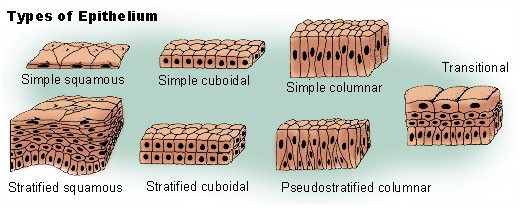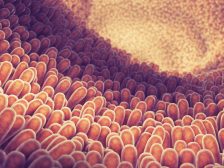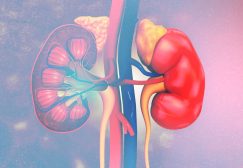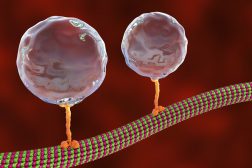Table of Contents
An epithelium is a type of animal tissue made up of densely packed cells (called epithelial cells) that rest on a basement membrane. Its function is to act as a covering or lining of various bodily surfaces and cavities. The epithelium is one of the five main types of animal tissues; the other four are nerve tissue, connective tissue, muscle tissue, and vascular tissue. The epithelium, in turn, is classified based on the number of layers that make up the tissue: simple, stratified, and pseudostratified. It may also be classified histologically, according to the cell shape: squamous, columnar, and cuboidal. The epithelium is found lining the body cavities and vessels, e.g. digestive tract and reproductive tract. It is primarily involved in providing protection of the underlying structures, secretory functions, transcellular transport, and selective absorption.
Epithelium definition

Epithelium (plural: epithelia) is a membranous animal tissue consisting of epithelial cells closely packed together and joined by cell junctions. Underneath the epithelial cell layer(s) is a basement membrane.
Etymology
The term epithelium came from New Latin epithēlium, which in turn came from the Ancient Greek ἐπί (epí), meaning “on” or “atop” and θηλή (thēlḗ), meaning “nipple”. The term epithelial is a descriptive word that means of, pertaining to, relating to, or characterized by an epithelium, as in epithelial cell, epithelial body. Synonym: epithelial tissue.
Types of epithelial tissues
The epithelium may be classified according to the number of layers that make it up: simple epithelium, stratified epithelium, and pseudostratified epithelium.
A simple epithelial tissue (also called simple epithelium) is an epithelial tissue made up of a single layer of epithelial cells. The cells lie in direct contact with the basement membrane.
A stratified epithelial tissue (also called stratified epithelium) is an epithelial tissue comprised of more than one layer of epithelial cells, with only the basal layer being in contact with the basement membrane, and often confers protective or mechanical function. A special type of stratified epithelium is the transitional epithelium. It consists of several layers of epithelial cells that can transition from squamous to cuboidal. The cells may contract or expand depending on the tension on the epithelium.(2)
A pseudostratified epithelial tissue (also called pseudostratified epithelium) is an epithelial tissue comprised of a single layer of epithelial cells that are in direct contact with the basement membrane. However, it appears stratified due to the positioning of the cells.
Comparison of the three major types of epithelium
| Simple epithelium | Stratified epithelium | Pseudostratified epithelium |
|---|---|---|
| Single layer of epithelial cells | Several layers of epithelial cells | Single layer of epithelial cells of varying cell sizes, resulting in looking like a stratified. |
Epithelial cell shapes:
|
Epithelial cell shapes:
|
Epithelial cell shape:
|
Functions:
|
Functions:
|
Functions:
|
Locations:
|
Locations:
|
Locations:
|
Special types
Special types of epithelium are the mesothelium and the endothelium. The mesothelium is the epithelial tissue in serous membranes lining the ventral body cavity and covering its organs, such as the linings in the pleural cavity, peritoneal cavity, and pericardial cavity. The endothelium is the type of epithelium that lines the blood vessels and the lymphatic vessels. Nevertheless, in pathology, these two are not considered as true epithelium since they have pathological features that are markedly different from those of other epithelial tissues. For instance, the cancer of the endothelium or of the mesothelium is referred to as sarcomas and the cancer involving the rest of the epithelial tissues as carcinomas.
Structure
The epithelium consists mainly of epithelial cells, which could be in a single layer (as in simple epithelium and pseudostratified) or in multiple layers (as in stratified epithelium). Underneath is a basement membrane that separates the epithelium from the connective tissue.
Epithelial cells
This tissue may be classified histologically according to the cell shape: (1) squamous epithelium, (2) columnar epithelium, and (3) cuboidal epithelium. Squamous epithelial cells are thin, flat cells looking like scales. They appear polygonal in shape when viewed from above. Columnar epithelial cells are rectangular, i.e. the cells appear taller than wide. Cuboidal epithelial cells are cube-shaped, i.e. the height and width of the cells are approximately the same.
Basement membrane
In the epithelium, the basement membrane is a thin, fibrous extracellular matrix located at the base, particularly under the epithelial cells. In metazoans, the basement membrane is the layer that separates the epithelial tissue from the connective tissue.(1) The basement membrane is comprised of two layers: basal lamina and reticular lamina. The basal lamina is produced by the secretions of the epithelial cells whereas the reticular lamina is produced by the secretions of the fibroblasts of the connective tissue.
Cell junctions
Cell junctions, such as tight junctions, adherens junctions, desmosomes, hemidesmosomes, and gap junctions, connect adjacent cells together. They are protein complexes that provide a bridge between contiguous cells or between a cell and the extracellular matrix.
Functions
The epithelium is primarily involved in providing protection to the underlying structures against abrasion, radiation, desiccation, and other physical trauma. Also, it prevents pathogens and toxins from easily entering the body. The skin, in particular, when disrupted, e.g. by a cut, provides a point of entry for pathogens and parasites. Thus, when the epithelial tissue is damaged, the body repairs it immediately through a cascade reaction involving several clotting factors and fibrin to seal it. Another crucial function of the skin is to provide sensation. The epithelial cells, in turn, are involved in various biological activities that enable secretion, regulation, and absorption. Glandular tissues are made up of epithelium. The two major types of glands are endocrine glands and exocrine glands.
Locations
Epithelial tissues may be found lining animal organs such as those of the reproductive tract and the digestive tract.
Development
During embryonic development, the epithelial tissues may come from any of the three germ layers. Certain cells from the ectoderm, for instance, may give rise to epidermis whereas certain cells from the endoderm may become the lining of the digestive tract. Certain cells from the mesoderm are fated to become the inner lining of the body cavities.
Related terms
- Barretts epithelium
- Crevicular epithelium
- Cylindrical epithelium
- Enamel epithelium
- Inner dental epithelium
- Muscle epithelium
- Olfactory epithelium
- Pavement epithelium
- Pigment epithelium
- Pigmented retinal epithelium
- Reduced enamel epithelium
- Simple epithelium
- Squamous epithelium
- Stratified ciliated columnar epithelium
- Stratified epithelium
- Stratified squamous epithelium
- Surface epithelium
See also
References
- Kierszenbaum, Abraham; Tres, Laura (2012). Histology and Cell Biology, An Introduction to Pathology (3rd ed.).
- Pratt, Rebecca. “Epithelial Cells”. AnatomyOne. Amirsys, Inc. Archived from the original on 2012-12-19. Retrieved 2012-09-28.
Further readings
- Klatt, E. C. (2019). Epithelium. Retrieved from Utah.edu website: https://webpath.med.utah.edu/HISTHTML/NORMAL/NORMAL05.html
- Brelje, C. (2019). Epithelium. Retrieved from Histologyguide.com website: http://www.histologyguide.com/slidebox/02-epithelium.html
- SIU SOM Histology INTRO. (2010). Retrieved from Siumed.edu website: http://www.siumed.edu/~dking2/intro/epith.htm
- 4.2 Epithelial Tissue – Anatomy and Physiology. (2013, March 6). Retrieved from Opentextbc.ca website: https://opentextbc.ca/anatomyandphysiology/chapter/4-2-epithelial-tissue/
© Biology Online. Content provided and moderated by Biology Online Editors






